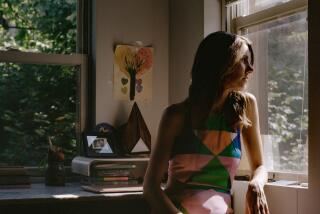An ink-stained wretch makes his pilgrimage to a shrine that probably will never be
Los Angeles has few literary shrines such as Mark Twain’s boyhood home in Hannibal, Mo., the Barrett residence at 50 Wimpole St. in London, and Samuel Johnson’s house off Fleet Street.
But there is an apartment on Laurel Avenue, in West Hollywood, that could become a shrine if it isn’t torn down first. It is where F. Scott Fitzgerald lived when he had a fatal heart attack in December, 1940, at the age of 44.
In this apartment and in a cottage he rented earlier in Encino (which has been torn down), Fitzgerald wrote “The Last Tycoon,” his novel of a Hollywood studio mogul. Though he left only six chapters and a pile of notes, critics have called it the best novel ever written about Hollywood.
Fitzgerald was in literary, financial and popular decline when he died, and, though he still had faith in his work, he could not foresee the fame and fortune that would be restored to him after his death.
When I was in high school, if one was clever one read Fitzgerald, Hemingway and Edna St. Vincent Millay, who burned her candle at both ends. Fitzgerald’s “Tender Is the Night” was a flop when it came out in 1934, but I will never forget the mood cast in my young mind by its first page, in which he described the rose-colored old hotel on the Riviera with its “bright tan prayer rug of a beach.”
I never saw Fitzgerald, but I am a friend of Frances Kroll Ring, who was his literary secretary and “gofer” during the last 20 months of his life. Ring has written a charming memoir of this period called “Against the Current: As I Remember F. Scott Fitzgerald” (Creative Arts Book Co.). She is gentle, shrewd, warm and elegant, and the book reflects these qualities on every page.
(Her subtitle comes from the last line of “The Great Gatsby,” Fitzgerald’s masterpiece--”So we beat on, boats against the current, borne back ceaselessly into the past.”)
She was “young and unworldly” when she got the job as Fitzgerald’s amanuensis through an employment agency. Just like that.
She went to his cottage on the Encino estate of the actor Edward Everett Horton. Fitzgerald interviewed her in his bedroom.
He did not hire her at once. He sent her to Western Union to wire $35 to his daughter, Scottie, who was away at Vassar. On the way she reflected: “He had asked me neither to take a letter nor to type anything. If it was going to be that kind of job I’d quit. Quit? He hadn’t even made me an offer.”
From Western Union she phoned to say that she had sent the money, and Fitzgerald told her to come to work the next morning. She had passed the $35 honesty test.
Ring had read a few of Fitzgerald’s stories but she was not ready for the man himself. He spent most of his days in bed. She was shocked to find that the tumbler on his nightstand was filled with gin, not water. One bureau drawer was filled with empty bottles. It was her job to spirit the bottles discreetly from the house.
One day after she found Horton, his landlord, poking among the empties in a trash barrel, Fitzgerald told her to buy burlap sacks and dispose of the bottles in them. It became her chore to fill burlap sacks with empties and surreptitiously toss them into a ravine as she was driving home over the pass.
In time, Fitzgerald controlled his drinking enough to work, and when he moved to West Hollywood, the book was well in hand. He wrote with a pencil on legal-sized paper and Ring typed every word, including the voluminous notes he made for plot and character. His schedule was erratic. Sometimes he would call her in the middle of the night with an idea or instructions.
All this time, she recalls, Fitzgerald was writing magazine articles and movies to support his wife, Zelda, a hospitalized schizophrenic, and their daughter.
Ring was fascinated by Fitzgerald’s affair with Sheilah Graham, the English Hollywood gossip columnist. “The first time I saw Sheilah Graham was about a week after I was hired. She arrived late one afternoon, breathless, blonde and smiling brightly. . . . The change that came over Scott when Sheilah walked into the room held me spellbound. . . . At first, I felt awkward and in the way--a witness to a clandestine affair. . . . Given today’s mores, it is hard to believe the precautions they took to avoid the tag of ‘living together.’ ”
Sometimes, when Sheilah was out of town, Ring would stay late at Fitzgerald’s, not because there was that much work to do, but because he hated facing the night alone.
“Once, in a frivolous, tipsy state,” she recalls, “he made a grab for me. I pulled away. He was immediately abashed, and said, ‘I won’t do that again. I wouldn’t want to think of Scottie in such a situation.’ ”
Fitzgerald moved to West Hollywood to be nearer Sheilah’s house, and there he fell dead beside her fireplace.
I drove out to Laurel Avenue the other day to see Fitzgerald’s apartment. It was still as Ring had described it. A pleasant-looking L-shaped building behind cypress trees and a lawn, a stone’s throw from where Schwab’s drugstore used to be. Fitzgerald’s number was upstairs at the back, in the crook of the L.
I didn’t ring the doorbell.
I had an idea that whoever lives there now would not want the place to become a shrine.
More to Read
Sign up for our Book Club newsletter
Get the latest news, events and more from the Los Angeles Times Book Club, and help us get L.A. reading and talking.
You may occasionally receive promotional content from the Los Angeles Times.








